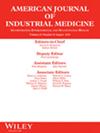Sick Leave and Its Associated Factors Among Pregnant Working Women in Egypt
Abstract
Background
As more women enter the workforce, particularly during their childbearing years, high sick leave rates during pregnancy are observed. The current study aimed to measure the prevalence and predictors of sick leave among pregnant workers and to compare it with pre-pregnancy levels.
Methods
A self-controlled, cross-sectional survey was conducted on 384 pregnant working women using an interviewer-administered questionnaire. Data included sociodemographic, medical, obstetric, and occupational histories, and details of sick leave during pregnancy and the preceding 9 months. Logistic regression analysis was used to identify significant independent predictors of sick leave during pregnancy.
Results
Prevalence of sick leave was significantly higher during pregnancy compared to the prior 9 months and in the third trimester compared to the other trimesters. Significant predictors were sociodemographic factors [adverse health (adjusted odd ration (AOR) 5.5; 95% CI 2.25–13.54), obstetric history (AOR 2.9; 95% CI 1.48–5.50) and multiparity (AOR 2.2; 95% CI 1.15–4.06)], and work-related factors [strenuous (AOR 16.9; 95% CI 5.91–48.35), or medium-skill occupations (AOR 14.1; 95% CI 3.85–50.32), and low job control (AOR 21.1; 95% CI 8.79–50.32)]. Pregnancy-related significant predictors were infertility treatment (AOR 11.4; 95% CI 2.4–54.2), nausea and vomiting (AOR 6.6; 95% CI 3.1–14.4), neck/back pain (AOR 6.1; 95% CI 3.1–11.9), and respiratory infections (AOR 3.1; 95% CI 1.6–6.2).
Conclusion
In Egypt, sick leave is common during pregnancy, particularly in the third trimester, due to factors related to work, health, and pregnancy. Workplace adjustments, such as flexible schedules and reduced physical demands, could help minimize sick leave and support pregnant employees.

 求助内容:
求助内容: 应助结果提醒方式:
应助结果提醒方式:


